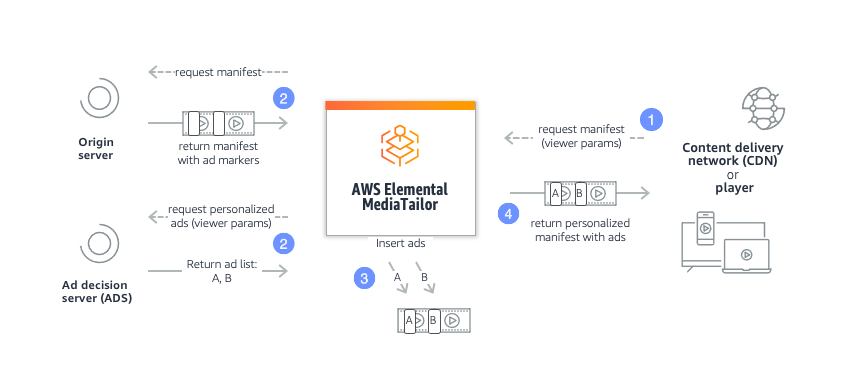Written by Nathan de Balthasar, Software Engineer at TrackIt
Digital advertising in broadcast and streaming environments depends on precise signaling to identify when and where ads should be inserted into video content. Whether for traditional cable television, over-the-top (OTT) platforms, or hybrid delivery models, this signaling must be accurate, standardized, and interoperable across multiple systems and workflows. The SCTE-35 standard is one of the core technologies enabling this functionality. It defines how cue messages are embedded within video streams to mark ad breaks, program segments, and other content boundaries.
This first article in the series on digital ad insertion technologies introduces SCTE-35, explains its role within broader ad workflows, and sets the stage for understanding how services like AWS Elemental MediaTailor leverage it for server-side ad insertion (SSAI).
Contents
What is SCTE-35?
The SCTE-35 standard, formally known as the Digital Program Insertion Cueing Message, specifies how content providers and distributors can signal opportunities for advertising, content replacement, and program control. It is widely applied across various delivery formats, including QAM/IP, TV Everywhere (e.g., HBO Max, FOX Sports), and both live and time-shifted delivery (e.g., DVR, VOD services like MyCanal and FreeBox TV).
SCTE-35 messages can signal:
- Start and end points for ad breaks.
- Placement of promotional or alternative content.
- Program chapter markers and segment boundaries.
- Content blackout instructions for regulatory compliance.
Related Standards
SCTE-35 works alongside other standards that address specific aspects of digital ad insertion:
- SCTE-30: Splicing advertising into live QAM MPEG-2 Transport Streams.
- SCTE-130-3: Enabling alternate content decisions for live and time-shifted delivery.
- SCTE-214-1: Defining how SCTE-35 is carried in MPEG-DASH.
- SCTE-224: Communicating event and policy information for distribution control.
The SCTE-67 (2024) document outlines recommended practices for implementing SCTE-35 in digital program insertion workflows for cable.
SCTE-35 Official standard: Digital Program Insertion Cueing Message
SCTE-35 Usage using HLS
In HTTP Live Streaming (HLS) workflows, SCTE-35 messages can be used to trigger seamless ad insertion through playlist (m3u8 manifest) manipulation. Before content reaches the player, the manifest can be updated to include targeted ad segments, enabling smooth playback without buffering.
Two primary HLS approaches for carrying SCTE-35 messages are:
- EXT-X-DATERANGE tags
- EXT-X-SCTE35 tags
These methods can also be adapted for MPEG-DASH using SCTE-214-1. In practice, ad insertion can be done client-side (CSAI) or server-side (SSAI). CSAI offers granular control but can be complex to implement seamlessly, while SSAI, such as that provided by AWS Elemental MediaTailor, centralizes the process on the server side and simplifies integration with live or VOD workflows.
The following documentation describes the ad insertion process using AWS Elemental MediaTailor.
Server-Side Ad Insertion using MediaTailor
AWS Elemental MediaTailor is a managed SSAI service that personalizes video streams by dynamically inserting ads based on viewer data and campaign targeting rules.
How Ad Servers Fit In
An ad server (ADS) determines which ads to deliver based on audience data, campaign parameters, and business rules. Based on a multitude of factors, including audience segments, budget, and timeline, the ad server calculates in real-time the best ads to load for a specific audience. Examples of Ad servers include Google Ad Manager (GAM), FreeWheel, or SpringServe.
The following illustration describes the process of serving ads using an ADS.
Source: The Video Ad Serving Process
- The user visits a site with a video player, which sends a request to the publisher’s web server to retrieve the video content.
- The server responds with code that tells the browser where to get the main video content from and how to format it in the player window.
- The video player should support HTML5 video and VAST tags for communication with ad servers.After the video content is fetched, the video player sends a request to the publisher’s ad server to retrieve a video ad (or at least the advertiser’s ad markup). This process requires sending a VAST request. The publisher’s ad server would also count an impression.
- The publisher’s ad server programmatically decides which ad to display in the ad space and sends back the chosen ad markup.The ad markup loads in the video player and sends a request to the advertiser’s ad server to retrieve the video ad.
- The advertiser’s ad server counts an impression and sends back a link that directs to the video ad’s location so it can be displayed to the user in the video player. Most of the time, the video ad would be hosted on a content delivery network (CDN).The video player sends a request to the CDN. The CDN returns the video ad file and the video ad is shown to the user
VAST Requests
For a video player to play an ad, it must send a VAST (Video Ad Serving Template) request to an ad server, specifying which ad should be played, how it should be played, and what information should be tracked during playback (e.g., CTR, exit or drop-off data, impressions).
A VAST request is a simple HTTP request with a query string such as:
The server response includes details like creative type, ID, dimensions, asset location, and tracking URLs.
More information can be found here: What Are VAST, VPAID, SIMID, OM, VMAP, and MRAID?
SSAI on MediaTailor
The following diagram illustrates the end-to-end workflow of server-side ad insertion with MediaTailor, from the video player to the ad decision server (ADS).

Source: How AWS Elemental MediaTailor Ad Insertion Works
- The player or CDN requests HLS or DASH content from MediaTailor, including parameters with viewer-specific information for ad personalization.
- MediaTailor forwards the request to the ADS, which selects an ad based on the viewer information and active campaigns. IThe ADS responds with URLs to the ad creatives in VAST or VMAP format.
- MediaTailor updates the content manifest to insert the selected ad URLs, transcoded to match the encoding characteristics of the original content.
- The personalized manifest is returned to the requesting player or CDN.
Conclusion
SCTE-35 is a foundational signaling standard for modern video advertising workflows, enabling precise ad insertion and content control across broadcast, cable, and OTT platforms. Understanding its role is critical for designing scalable, interoperable ad-supported streaming architectures.
Organizations looking to implement or optimize SSAI solutions can benefit from leveraging AWS Elemental MediaTailor’s native SCTE-35 integration, streamlining the delivery of personalized, high-quality ad experiences. TrackIt offers expertise in configuring and integrating these workflows, ensuring that technical execution aligns with both operational goals and monetization strategies.
Coming Next – Part 2: How AWS MediaTailor Handles SCTE-35 Markers
The next article in this series will take a deep dive into how AWS MediaTailor ingests SCTE-35 markers, interprets cue messages, and manipulates manifests to enable real-time server-side ad insertion. It will include architectural diagrams, example workflows, and best-practice recommendations for reliable, scalable deployments.
About TrackIt
TrackIt is an international AWS cloud consulting, systems integration, and software development firm headquartered in Marina del Rey, CA.
We have built our reputation on helping media companies architect and implement cost-effective, reliable, and scalable Media & Entertainment workflows in the cloud. These include streaming and on-demand video solutions, media asset management, and archiving, incorporating the latest AI technology to build bespoke media solutions tailored to customer requirements.
Cloud-native software development is at the foundation of what we do. We specialize in Application Modernization, Containerization, Infrastructure as Code and event-driven serverless architectures by leveraging the latest AWS services. Along with our Managed Services offerings which provide 24/7 cloud infrastructure maintenance and support, we are able to provide complete solutions for the media industry.

